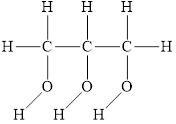
(a)
Interpretation:
The intermolecular interactions that operate in
Concept introduction:
There are three types of interactions through which the molecules are stabilized. They are hydrogen-bonding interactions, the dipole-dipole interactions and the induced dipole interactions. These interactions influence the properties of the compounds like boiling point, melting point and so on.
Answer to Problem 39E
The intermolecular interactions that operate in
Explanation of Solution
In all molecular substances, the intermolecular interactions exist. These interactions are induced dipole interactions, dipole-dipole interactions and hydrogen bonding.
The structure of

Figure 1
The molecule has electronegative atom
The intermolecular interactions that operate in
(b)
Interpretation:
The intermolecular interactions that operate in
Concept introduction:
There are three types of interactions through which the molecules are stabilized. They are hydrogen-bonding interactions, the dipole-dipole interactions and the induced dipole interactions. These interactions influence the properties of the compounds like boiling point, melting point and so on.
Answer to Problem 39E
The intermolecular interactions that operate in
Explanation of Solution
In all molecular substances, the intermolecular interactions exist. These interactions are induced dipole interactions, dipole-dipole interactions and hydrogen bonding.
The structure of

Figure 2
The molecule has electronegative atom
The intermolecular interactions that operate in
(c)
Interpretation:
The intermolecular interactions that operate in
Concept introduction:
There are three types of interactions through which the molecules are stabilized. They are hydrogen-bonding interactions, the dipole-dipole interactions and the induced dipole interactions. These interactions influence the properties of the compounds like boiling point, melting point and so on.
Answer to Problem 39E
The intermolecular interactions that operate in
Explanation of Solution
In all molecular substances, the intermolecular interactions exist. These interactions are induced dipole interactions, dipole-dipole interactions and hydrogen bonding.
The structure of

Figure 3
The molecule has electronegative atom
The intermolecular interactions that operate in
(d)
Interpretation:
The intermolecular interactions that operate in
Concept introduction:
There are three types of interactions through which the molecules are stabilized. They are hydrogen-bonding interactions, the dipole-dipole interactions and the induced dipole interactions. These interactions influence the properties of the compounds like boiling point, melting point and so on.
Answer to Problem 39E
The intermolecular interactions that operate in
Explanation of Solution
In all molecular substances, the intermolecular interactions exist. These interactions are induced dipole interactions, dipole-dipole interactions and hydrogen bonding.
The structure of

Figure 4
The molecule has electronegative atom
The intermolecular interactions that operate in
(e)
Interpretation:
The intermolecular interactions that operate in
Concept introduction:
There are three types of interactions through which the molecules are stabilized. They are hydrogen-bonding interactions, the dipole-dipole interactions and the induced dipole interactions. These interactions influence the properties of the compounds like boiling point, melting point and so on.
Answer to Problem 39E
The intermolecular interactions that operate in
Explanation of Solution
In all molecular substances, the intermolecular interactions exist. These interactions are induced dipole interactions, dipole-dipole interactions and hydrogen bonding.
The structure of

Figure 5
The molecule does not have any has electronegative atom. This means the polarity is not present in the molecule. This molecule can form bond with other molecule through the induced dipole interactions. Therefore, the dominant intermolecular interaction in this molecule is induced dipole interaction.
The intermolecular interactions that operate in
Want to see more full solutions like this?
Chapter 15 Solutions
EBK INTRODUCTORY CHEMISTRY: AN ACTIVE L
- What is the final product when D-galactose reacts with hydroxylamine?arrow_forwardIndicate the formula of the product obtained by reacting methyl 5-chloro-5-oxopentanoate with 1 mole of 4-penten-1-ylmagnesium bromide.arrow_forwardIn the two chair conformations of glucose, the most stable is the one with all the OH groups in the equatorial position. Is this correct?arrow_forward
- please help me with my homeworkarrow_forwardhelparrow_forwardThe temperature on a sample of pure X held at 1.25 atm and -54. °C is increased until the sample boils. The temperature is then held constant and the pressure is decreased by 0.42 atm. On the phase diagram below draw a path that shows this set of changes. pressure (atm) 2 0 0 200 400 temperature (K) Xarrow_forward
- QUESTION: Answer Question 5: 'Calculating standard error of regression' STEP 1 by filling in all the empty green boxes *The values are all provided in the photo attached*arrow_forwardpressure (atm) 3 The pressure on a sample of pure X held at 47. °C and 0.88 atm is increased until the sample condenses. The pressure is then held constant and the temperature is decreased by 82. °C. On the phase diagram below draw a path that shows this set of changes. 0 0 200 temperature (K) 400 аarrow_forwarder your payment details | bar xb Home | bartleby x + aleksogi/x/isl.exe/1o u-lgNskr7j8P3jH-1Qs_pBanHhviTCeeBZbufuBYT0Hz7m7D3ZcW81NC1d8Kzb4srFik1OUFhKMUXzhGpw7k1 O States of Matter Sketching a described thermodynamic change on a phase diagram 0/5 The pressure on a sample of pure X held at 47. °C and 0.88 atm is increased until the sample condenses. The pressure is then held constant and the temperature is decreased by 82. °C. On the phase diagram below draw a path that shows this set of changes. pressure (atm) 1 3- 0- 0 200 Explanation Check temperature (K) 400 X Q Search L G 2025 McGraw Hill LLC. All Rights Reserved Terms of Use Privacy Cearrow_forward
 Introductory Chemistry: An Active Learning Approa...ChemistryISBN:9781305079250Author:Mark S. Cracolice, Ed PetersPublisher:Cengage Learning
Introductory Chemistry: An Active Learning Approa...ChemistryISBN:9781305079250Author:Mark S. Cracolice, Ed PetersPublisher:Cengage Learning World of Chemistry, 3rd editionChemistryISBN:9781133109655Author:Steven S. Zumdahl, Susan L. Zumdahl, Donald J. DeCostePublisher:Brooks / Cole / Cengage Learning
World of Chemistry, 3rd editionChemistryISBN:9781133109655Author:Steven S. Zumdahl, Susan L. Zumdahl, Donald J. DeCostePublisher:Brooks / Cole / Cengage Learning World of ChemistryChemistryISBN:9780618562763Author:Steven S. ZumdahlPublisher:Houghton Mifflin College Div
World of ChemistryChemistryISBN:9780618562763Author:Steven S. ZumdahlPublisher:Houghton Mifflin College Div Introductory Chemistry: A FoundationChemistryISBN:9781337399425Author:Steven S. Zumdahl, Donald J. DeCostePublisher:Cengage Learning
Introductory Chemistry: A FoundationChemistryISBN:9781337399425Author:Steven S. Zumdahl, Donald J. DeCostePublisher:Cengage Learning Chemistry: The Molecular ScienceChemistryISBN:9781285199047Author:John W. Moore, Conrad L. StanitskiPublisher:Cengage Learning
Chemistry: The Molecular ScienceChemistryISBN:9781285199047Author:John W. Moore, Conrad L. StanitskiPublisher:Cengage Learning Principles of Modern ChemistryChemistryISBN:9781305079113Author:David W. Oxtoby, H. Pat Gillis, Laurie J. ButlerPublisher:Cengage Learning
Principles of Modern ChemistryChemistryISBN:9781305079113Author:David W. Oxtoby, H. Pat Gillis, Laurie J. ButlerPublisher:Cengage Learning





